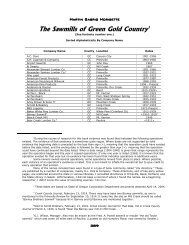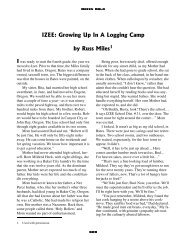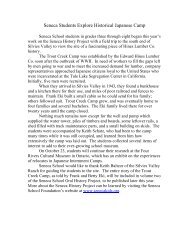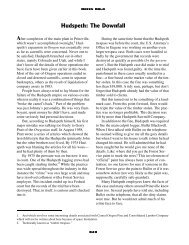"Time Travel in Seneca" Oregon Trail Ruralite, January 2007
"Time Travel in Seneca" Oregon Trail Ruralite, January 2007
"Time Travel in Seneca" Oregon Trail Ruralite, January 2007
Create successful ePaper yourself
Turn your PDF publications into a flip-book with our unique Google optimized e-Paper software.
Seneca Students <strong>Travel</strong> Back <strong>in</strong><br />
<strong>Time</strong> With Oral History Project<br />
By B. Marie Jarreau-Danner<br />
Many Seneca residents<br />
remember the one room,<br />
yellow, "cheese-box" houses<br />
now melted <strong>in</strong>to the rich history of<br />
their town.<br />
In the heyday of logg<strong>in</strong>g operations<br />
<strong>in</strong> Seneca, some employees<br />
temporarily lived <strong>in</strong> the small square<br />
structures resembl<strong>in</strong>g big blocks<br />
of cheese. Others lived <strong>in</strong> boxcars<br />
turned <strong>in</strong>to bunkhouses.<br />
A few of those have been <strong>in</strong>corporated<br />
<strong>in</strong>to houses still <strong>in</strong> use <strong>in</strong><br />
Seneca today.<br />
Seneca students know how those<br />
shelters fit <strong>in</strong>to the development of<br />
their town, and much more.<br />
As if travel<strong>in</strong>g back <strong>in</strong> time, the<br />
students are learn<strong>in</strong>g about Seneca's<br />
logg<strong>in</strong>g and railroad past, and about<br />
the historic lives and experiences of<br />
their ancestors and other residents.<br />
Us<strong>in</strong>g a cont<strong>in</strong>u<strong>in</strong>g series of <strong>in</strong>terviews,<br />
research tools, artwork and<br />
artifacts, the entire school has been<br />
<strong>in</strong>volved <strong>in</strong> the oral history project<br />
for more than five years.<br />
Seneca head teacher Adele Cerny<br />
said the idea came <strong>in</strong> 2001 from<br />
Seneca teacher Judith Beaudet Reed.<br />
With help from other school and<br />
community members, the project<br />
has grown to <strong>in</strong>clude publication of<br />
a book, "Seneca School Oral History<br />
Project," development of two large<br />
murals, a detailed history time l<strong>in</strong>e,<br />
historical site maps and a museum<br />
collection.<br />
A three-dimensional model<br />
of Seneca, <strong>in</strong>clud<strong>in</strong>g a tra<strong>in</strong> that<br />
hauled logs to H<strong>in</strong>es, is under<br />
construction.<br />
Eighteen former and present<br />
Seneca residents have been <strong>in</strong>terviewed.<br />
Their stories are archived<br />
<strong>in</strong> the publication.<br />
"We created eight <strong>in</strong>terview<br />
teams, where younger students<br />
were paired with older students,"<br />
said Judith. "Even the first-graders<br />
were encouraged to take notes.<br />
Later, they all worked together with<br />
their notes and memories of the conversations.<br />
Teachers helped them<br />
blend the <strong>in</strong>formation together."<br />
Through research and <strong>in</strong>terviews<br />
students gathered <strong>in</strong>formation<br />
about life <strong>in</strong> Seneca that focused on<br />
the presence of the Edward H<strong>in</strong>es<br />
Western P<strong>in</strong>e Company.<br />
"We wanted to learn more about<br />
the history of Seneca when it was a<br />
logg<strong>in</strong>g town <strong>in</strong> the 1930s through<br />
1950s," student Clay Hughet expla<strong>in</strong>ed<br />
dur<strong>in</strong>g a recent presentation.<br />
More than 100 people attended<br />
the debut of the publication on<br />
November 1. Students spoke to visitors<br />
about future goals of the project,<br />
and presented the artifact collection,<br />
the time l<strong>in</strong>e and the large murals.<br />
Colorful details of historic events<br />
and prom<strong>in</strong>ent locations around<br />
Seneca are showcased <strong>in</strong> the murals.<br />
While artist-<strong>in</strong>-residence Carol<br />
Poppenga guided development and<br />
construction of the large art pieces,<br />
the students determ<strong>in</strong>ed which<br />
scenes would be depicted.<br />
"One of the challenges for her<br />
was that every student had to be <strong>in</strong>cluded<br />
<strong>in</strong> the work from the sketch<strong>in</strong>g<br />
phase to apply<strong>in</strong>g the pa<strong>in</strong>t<strong>in</strong>g,"<br />
said Judith.<br />
One of the mural scenes illustrates<br />
"a man runn<strong>in</strong>g as fast as he can from<br />
his cheese-box house to the outhouse<br />
<strong>in</strong> his red long-johns because it was<br />
so-o-o cold," second-grader Jessica<br />
Carter expla<strong>in</strong>ed with a giggle.<br />
Youngsters were <strong>in</strong>trigued to hear<br />
<strong>in</strong>terviewees speak about the record<br />
m<strong>in</strong>us-54 degrees Fahrenheit recorded<br />
<strong>in</strong> Seneca <strong>in</strong> February 1933,<br />
mak<strong>in</strong>g the small rural town the<br />
coldest spot <strong>in</strong> <strong>Oregon</strong>.<br />
Students learned about jobs that<br />
def<strong>in</strong>ed Seneca's logg<strong>in</strong>g era: cha<strong>in</strong><br />
pullers, kiln men, planers, trimmers.<br />
They also learned about others who<br />
provided support for the overall operations:<br />
store owners, hotel keepers,<br />
teachers, homemakers, mach<strong>in</strong>ists<br />
and health care providers.<br />
Sue Pynes Woodford Beals lived<br />
<strong>in</strong> Seneca <strong>in</strong> the 1930s and 40s. She<br />
told the students her family lived <strong>in</strong><br />
a cheese-box house before she was<br />
born. They used home remedies for<br />
health care when it was impractical to<br />
get to doctors <strong>in</strong> Burns or John Day.<br />
For <strong>in</strong>termediate ailments local nurse<br />
Car<strong>in</strong>e Williams was usually called.<br />
Leonard Trafton lived <strong>in</strong> Seneca<br />
from 1947 to 1969. He and his family<br />
lived <strong>in</strong> a house that had been<br />
a cheese-box house. Later, it was<br />
renovated and enlarged. Leonard<br />
also told the students about nurse<br />
Williams. He said Dr. John Weir<br />
traveled from Burns to Seneca once<br />
each week to take care of cuts,<br />
bone breaks and ailments more<br />
difficult than could be handled by<br />
the nurse or home remedies.<br />
The students learned how the<br />
community shared what it had,<br />
and how cohesively residents<br />
worked and played together.<br />
Students heard stories about<br />
logg<strong>in</strong>g, gandy dancers—railroad<br />
repair crews—cold weather, rabbit<br />
hunt<strong>in</strong>g <strong>in</strong> deep snow, Seneca<br />
money, black woolies, mill wages,<br />
jammers, and trad<strong>in</strong>g with the<br />
Umatilla and Paiute <strong>in</strong>dians and<br />
28 JANUARY <strong>2007</strong> OREGON TRAIL
Above, Seneca School Ambassadors present historical and technical <strong>in</strong>formation about the latest mural that depicts scenes of Seneca s<br />
history: Opposite page, Rheanna Cartner offers an orig<strong>in</strong>al sketch of Seneca s former nurse Car<strong>in</strong>e Williams for <strong>in</strong>clusion <strong>in</strong> the<br />
mural. Photo courtesy of Seneca School.<br />
experienc<strong>in</strong>g their culture.<br />
They learned of the Seneca swimm<strong>in</strong>g<br />
pool and found remnants of it<br />
dur<strong>in</strong>g their archaeological tours.<br />
John Saunders told <strong>in</strong>terviewers<br />
about be<strong>in</strong>g a young man <strong>in</strong> the area.<br />
He said they collected all the animal<br />
hides they could f<strong>in</strong>d to trade with the<br />
Native Americans, who would come<br />
down from Pendleton and Umatilla<br />
"<strong>in</strong> a mile-long l<strong>in</strong>e with travois."<br />
The hides were traded for gloves<br />
with gauntlets and fancy beadwork,<br />
and for work gloves.<br />
Deer were plentiful, Saunders<br />
said, but elk was scarce.<br />
An excerpt from the book expla<strong>in</strong>s<br />
what happens when a couple of boys<br />
get <strong>in</strong>to trouble:<br />
One time he was with his cous<strong>in</strong>s and<br />
they came upon an Indian grave. Not<br />
know<strong>in</strong>g any better, they took copper<br />
buckets and Indian beads home. His aunt<br />
got all over them and chased them back to<br />
the grave. They reburied the items.<br />
Through this project, generations<br />
of Seneca students are gett<strong>in</strong>g the<br />
sense of the economic changes that<br />
have altered their town.<br />
Remember<strong>in</strong>g his logg<strong>in</strong>g days<br />
<strong>in</strong> Seneca, Leo (Duce) Charles<br />
McKrola told of one tree logged <strong>in</strong><br />
the Murderers Creek area that measured<br />
18,000 board feet and eight<br />
feet <strong>in</strong> diameter—"Enough to build<br />
an entire house," he told students.<br />
The loss of that <strong>in</strong>dustry brought<br />
much change to Seneca.<br />
Historians Jack Southworth,<br />
Dennis Smith and Mart<strong>in</strong> Morisette,<br />
and the U.S. Forest Service, are<br />
among those who provided support<br />
for the school and the oral history<br />
project.<br />
Morisette's Web site, www.<br />
co-greengold.com, is devoted to<br />
<strong>Oregon</strong>'s logg<strong>in</strong>g history and hosts<br />
Seneca School's Web page.<br />
As they travel back <strong>in</strong> time through<br />
conversations with older residents,<br />
students have been able to share<br />
<strong>in</strong> the memories of Seneca's past.<br />
Through their project, they also are<br />
preserv<strong>in</strong>g those historical accounts<br />
for future generations. ■<br />
For more <strong>in</strong>formation about the project<br />
or to purchase Seneca School Oral<br />
History Project contact the Seneca School<br />
at (541) 542-2542.<br />
t<br />
OREGON TRAIL JANUARY <strong>2007</strong> 29







